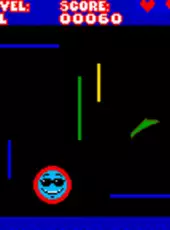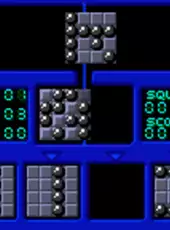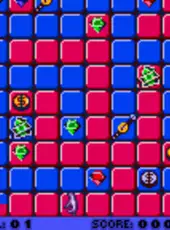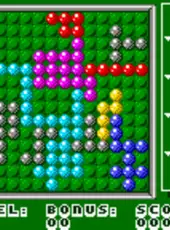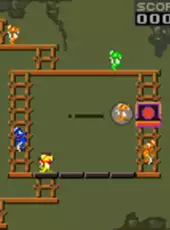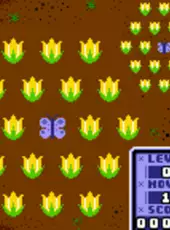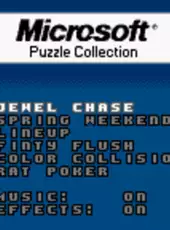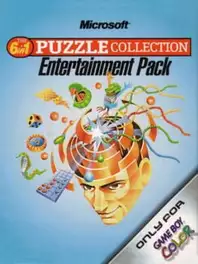
Microsoft Puzzle Collection Entertainment Pack - Video
Genres:
Strategy, Puzzle, Card & Board Game
Platform:
Game Boy Color
A Game Boy version of the Windows puzzle suite of the same name, featuring 6 of the 10 games released on PC, designed by Alexey Pajitnov, the original Tetris designer, on one Gameboy Color cartridge.
Jewel Chase. A level based game. Every level consists of a labyrinth of colored pathways, scattered valuables, locked doors, keys, a thief (the player), on some levels an opposing thief and a door marked exit. The goal is to reach the exit to proceed to the next level, valuables can be 'stolen' for score. If the opposing (computer controlled) thief reaches the exit before the player, the game is lost. Movement is not possible between differently colored tiles, unless a special, multicolor 'bridge' stone is used. 99 levels total.
Spring weekend. A rotation puzzle, where a given pattern needs to be recreated by rotating elements on the playfield.
Lineup. Using 'Tetris' style blocks, a continuous line from a screen border to an opposite screen border needs to be build. Elements appear on an element stack, and can be selected freely from that and subsequently placed anywhere on screen, without overlapping each other. If the element stack is full, the game is over. As soon as a line is complete, the elements of that line are removed from the screen. Elements appear faster over time.
Finty Flush. A grid on top of the screen fills slowly with multicolor balls. The player can pick one out of 4 squares on the bottom of the screen to shift balls in one line into and out of these squares. The squares can be rotated in 90 degree steps. As soon as any square is completely full with balls of the same color, its content empties to make room for more balls. 3 filled square grids grant a bonus point, and the next level begins (tiles appear faster). The game is over when the upper grid is full.
Color Collision. A 'Qix' style ray ( no better way to describe this - for the younger audience - imagine a flapping fan ) moves with increasing speed through a screen full of obstacles. The player can only indirectly control it - any time the direction pad is pressed, it gets 'reflected' into the direction that has been indicated. Objective is to hit obstacles with a given color and pattern, avoiding all other elements. To top things of, the patterns change over time. The game ends if the wrong obstacles have been hit too many times.
Rat Poker. Little differently colored rats are automatically fed into labyrinths, with labyrinth design changing and getting more complex during level progression. Switches allow rerouting of the rats to arrange certain color combinations ('hands') of rats. If a given combination is achieved, the contributing rats exit the playfield through a door. You progress to the next level if a given number of rats has been removed from the game. The game ends if there is no space left on the playfield for additional rats.
.
Jewel Chase. A level based game. Every level consists of a labyrinth of colored pathways, scattered valuables, locked doors, keys, a thief (the player), on some levels an opposing thief and a door marked exit. The goal is to reach the exit to proceed to the next level, valuables can be 'stolen' for score. If the opposing (computer controlled) thief reaches the exit before the player, the game is lost. Movement is not possible between differently colored tiles, unless a special, multicolor 'bridge' stone is used. 99 levels total.
Spring weekend. A rotation puzzle, where a given pattern needs to be recreated by rotating elements on the playfield.
Lineup. Using 'Tetris' style blocks, a continuous line from a screen border to an opposite screen border needs to be build. Elements appear on an element stack, and can be selected freely from that and subsequently placed anywhere on screen, without overlapping each other. If the element stack is full, the game is over. As soon as a line is complete, the elements of that line are removed from the screen. Elements appear faster over time.
Finty Flush. A grid on top of the screen fills slowly with multicolor balls. The player can pick one out of 4 squares on the bottom of the screen to shift balls in one line into and out of these squares. The squares can be rotated in 90 degree steps. As soon as any square is completely full with balls of the same color, its content empties to make room for more balls. 3 filled square grids grant a bonus point, and the next level begins (tiles appear faster). The game is over when the upper grid is full.
Color Collision. A 'Qix' style ray ( no better way to describe this - for the younger audience - imagine a flapping fan ) moves with increasing speed through a screen full of obstacles. The player can only indirectly control it - any time the direction pad is pressed, it gets 'reflected' into the direction that has been indicated. Objective is to hit obstacles with a given color and pattern, avoiding all other elements. To top things of, the patterns change over time. The game ends if the wrong obstacles have been hit too many times.
Rat Poker. Little differently colored rats are automatically fed into labyrinths, with labyrinth design changing and getting more complex during level progression. Switches allow rerouting of the rats to arrange certain color combinations ('hands') of rats. If a given combination is achieved, the contributing rats exit the playfield through a door. You progress to the next level if a given number of rats has been removed from the game. The game ends if there is no space left on the playfield for additional rats.
.
Released on Aug 01st 2000
×
![]()

